
FLORICANTO PRESS NEWS
Mujeres de Conciencia/ Women of Conscience. Spanish English parallel text and photography by Victoria Alvarado. ISBN: 978-0-9796457-7-8. 2008 $69.95 Oversize Hard bound. Especial Holiday advanced purchase for individual customers $49.95. Save $20.00
This is an art book with magnificent black and white photos of prominent Latinas who have made definite and long standing contribution to the Hispanic community and the country at large. This photographic essay constitutes an important collective biography as well, with great journalistic insight and integrity into the lives of leading Latina women in the fields of education, science, literature, business, law, the arts, journalism, politics, and other fields of endeavor. This coffee table monograph, which has been published with art-book quality as a collector's edition, provides stunning artistic, B&W photographs of each subject with a parallel biographic journalistic essay in Spanish and English. The biographies explore the life-changing events of each subject, the personal mix of elements, circumstances, and values which allowed these women to set goals and objectives toward most successful careers and contributions to society. There are 72 leading women included in this collective biography and an extraordinary photographic essay offering the most incredible array of role models to inspire, guide and motivate young Latinas. This title is an important addition to reference collections and individual libraries for they are testament to the vision and values of la mujer Latina.
Operation Familia. By Donna del Oro. ISBN: 978-0-915745-96-8. 520 pages. $24.95
Dina Salazar likes to think she has it together. Dodging the bullet of early marriage and motherhood that every other female in her family has succumbed to, she_s her own woman. Or is she? Is she free ...or just lost?
Adventurous, athletic Dina has a satisfying career and her freedom from emotional entanglements. She has it all. All except the love of her life, Rick Ramos_THE HATED ONE--who ended up marrying another woman nearly six years before. All except the closeness of her blue-collar family, who live in a latino barrio of Salinas, ninety miles south of Silicon Valley. All except the feeling of belonging to her cultural heritage. She speaks Spanish but who is she really? Is she a mixed mutt with an American mind and a latino heart? In her attempts at educating herself and climbing the socio-economic ladder into the middle-class, has Dina lost her latino heart and soul? Then, like an artichoke, Dina begins to peel away the secrets to get at the heart of her family. When Dina learns that her stern, disapproving Mexican-born grandmother has a shameful secret-- a son Grandma Gómez had to abandon in Mexico sixty years before-- Dina is reluctant at first to get involved. The uncle she has never known has died mysteriously-- killed, her grandmother believes, by a rival in the Juarez drug cartel. And Abuelita_s grand-daughter, Teresa--Dina_s Mexican cousin-- is in danger and is on the run. To Dina_s dismay, her grandmother urges HER to find out where her grand-daughter and great grandson are seeking refuge in Mexico. Her grandmother tells her that Dina is the only one that can rescue Teresa and her son, for Dina is the only one who speaks fluent Spanish. What_s a girl to do when la familia calls?
"A delightful, endearing story! You can_t help but root for Dina in her journey of self-discovery."--Brenda Novak, Nationally Best-selling Author
"Dina is a character that many Latinos can identify with a woman trying to weave her own place between cultures. Around Dina, Donna Del Oro has done her own weaving: a heady plot of crime, romance, family conflict and intrigue."
--Carlos Alcalá, Sacramento Bee Columnist
Shadow of the Fathers. By Robert Friedman. ISBN: 978-0-915745-75-3. 2007. $14.95
In Shadow of the Fathers, Robert Friedman turns a disturbing, possibly tragic historical event in Puerto Rico into a captivating work of fiction. Personal obsessions and public events collide as the novel's characters grapple with lies, false identities, puzzling connections, U.S. wars and colonialism. A rich, suspenseful tale, the novel moves from the colorful life of San Juan to the snow-covered streets of New York, from the pastel heat of Miami to the fog-shrouded canals of Amsterdam. Pablo Camino is the son of a doctor sent to Puerto Rico over four decades earlier to research a cure for pernicious anemia. While there, Dr. Cornelius Rhoads claimed in a letter to his close friend, "Ferdie" that he had purposely killed eight of his Puerto Rican patients and planned to exterminate several more of "that degenerate race." The letter was discovered and Rhoads was forced to leave the island. He later insisted it was all a joke. Pablo, a highly regarded Puerto Rican artist, is haunted by his dead father's past. Did the doctor really kill those patients? Has Pablo inherited from him the feelings of murder that often grip his own heart? When Pablo kills an intruder in his home, he vows to finally discover the truth about the father he never knew -and about himself. He flees Puerto Rico to look for Ferdie. Back on the island, Ralph Camacho, Pablo's best friend, carries out his own search into a past that casts heavy shadows on individual lives in the present.
Diadema. Carlos Aceves. ISBN: 978-0-9796457-6-1 $24.95
Carlos Aceves has created an allegorical story rooted in the deepest essence of the Latino soul. Diadema is a symbolic artifice very much like Doña Marina, La Malinche, searching for her child, her very being. Knitted in a true story, Aceves bring forward the Latino imperative of who really are we? What are our roots? This is the Hispanic crucial element of understanding self. Latinos are not alone. Spain if often called by Spaniards "the whore of Europe" for it was invaded by most every group in Europe creating a concatenation of races and cultures; today there are over five different languages spoken there. Latinos to a certain extent inherited this dilemma, and Aceves attempts to use fiction weaved in reality to address the Latino, Chicano predicament of self-preservation and self-understanding. Aceves propounds a clear lyric message begin your journey for genuineness and self-understanding and let the road lead you where it may: "Se hace camino al andar." Roberto Cabello-Argandoña, Editor.
Unamuno: A Lyrical Essay.
By Pedro Blas González. ISBN: 978-0-915745-75-3 $22.95
The most extraordinary and exemplary piece of Latino prose writing, bordering in Rational lyricism. Scholarship and art in Europe, traditionally crisscrossed each other, particularly when the brightest minds where at it. Germany has Goethe, the Hispanic world has Unamuno. Both were consummated philosophers and creative writers, who left indelible marks, both in culture and philosophical argumentation. Goethe's "Werther" is credited with initiating Romanticism in Europe. "El Sentido Trágico de La Vida" ponders the ever-present human (and Hispanic) preoccupation for life, death and beyond, immortality. However, it takes a Latino scholar to analyze, scaffold, and present in an very understandable way to us the grandiosity of Unamuno's philosophical concerns and his scrupulous argumentation. Dr. Pedro Blas González is the first Latino scholar to elaborate and deconstruct Unamuno's philosophical work and related creative writings. This is a lyric work of prose, as well as of literary criticism, philosophical analysis, and pure rigorous Latino erudition advancing Hispanic thinking. Roberto Cabello-Argandoña, Editor.
Waves of Recovery: The Life of an Advocate of Latino Civil Rights. By Maurice Jourdane. ISBN: 978-0-915745-95-1 $26.95
This a riveting personal account of Maurice Jourdane--currently a Superior Court Judge and a member of Jerry Brown's California Attorney General's Office--leading to his legal representation and advocacy for farm workers and César Chávez's organizing efforts. Mo's life reads like a Greek mythic tale in which the hero suffers and endures moral and physical affliction in his quest, his now legendary legal fights and successes against the powerful California growers and agricultural interests in court. This biography is a testament to human strength in behalf of justice for Latinos. The success of César Chávez's civil rights movement and union organizing efforts cannot be fully understood without knowledge of the life and sacrifices of Maurice Jourdane, El Cortito. His legal successes, at great personal costs, solidified Chávez's leadership and prepared the way for the consolidation of the Farm Workers' Union, and ultimately for the farm workers to prevail against the powerful political and economic interests of the California growers. Roberto Cabello-Argandoña, Editor.
Latina Filmmakers and Writers: The Notion of Chicanisma Through Films and Novellas. Jenny Dean. ISBN: 978-0-9796457-1-6. $26.95
During the Chicano Movement in the 1960s and 1970s, Chicanas helped Chicanos achieve equal rights, while at the same time suffered oppression as women within their own race. In the 1970s, the Chicana Feminist Movement was founded to address the specific needs of Chicanas as women of color in the United States. Chicana artists began to write and produce works in which Chicanas were given a proper name, voice, and image. Soon, Chicanisma, a sense of sisterhood and feminist discourse, emerged to confront the triple oppression of race, class, and gender. Latina Filmmakers and Writers: The Notion of Chicanisma Through Films and Novellas examines the works of seven celebrated Latinas who collectively represent a 20-year history of Chicanisma: Chicana (a film by Sylvia Morales), Puppet: A Chicano Novella (a book by Margarita Cota-Cárdenas), La Ofrenda: The Days of the Dead (a film by Lourdes Portillo and Susana Muñoz), Paletitas de Guayaba (a book by Erlinda Gonzáles-Berry), El Espejo/The Mirror (a film by Frances Salomé España) and Loving Pedro Infante (a book by Denise Chávez). These works demystify masculine power and offer realistic portrayals of Chicanas and give them a rightful name, image, and voice in American culture.
"Dean provides a thoughtful and honest account of ... the concept of Chicanisma. Latina Filmmakers and Writers cleverly situates Chicana literature and film at the perilous yet unique intersection of class, gender and race ...and weaves a Chicana feminist theory and original oral history research " Guisela Latorre, University of California. Santa Barbara.
"This book deals with the voices and works of Latinas [whose voices]... must be heard since they elaborate on the concept of "Chicanisma."This is an important new book in the development of Chicana Studies and Latina thought. Kudos!" Dr. Luzma Umpierre, Human Rights Advocate.
"...This book... is a must read text for contemporary society. ...[it] will be most helpful in Chicana and Chicano Studies, Women and Feminist Studies, Ethnic Studies, and Cultural Studies in understanding the experiences and issues concerning diversity in a postmodern situation." Dr. T. Osa Hidalgo de la Riva
Huevos y la Mujer Latina: The De-masculinization of the Macho. Julián Camacho-Segura. ISBN: 978-0-9796457-4-7 $19.95
Huevos is not a politically correct articulation of the plight of Latino men in this era of so called gender equity and diversity. The author contends that while White women have made progress, Latinos, particularly Mexican men, have been entirely ignored; they have become the epitome of the poor working class. Ambitious and upward mobile Latinas often look down upon Latinos, and particularly Mexican males' lackluster economic success preferring other males. Latino males have been left out of any gender or racial discussion, yet suffer the highest work related death rates, lowest college attendance and graduation rates, high incarceration rates, the highest poverty even though they have the highest labor participation rates. The Latino male have become the Sisyphus's of America condemned to low wages by globalization, to ignorance by mediocre, highly-unionized schools, and destined to be marginalized of any equity-political-solution.
The progress of White women has maintained White power by driving the diversity dialog, praxis, and remedy away from Latino males-the working, and uneducated poor. As Latino men have been relegated to a caste style social gender structure-the hard working indigent-Latinas have been blinded into believing that feminism and Chicanisma are positive, weakening Latino traditional social fabric and support system, while simultaneously ignoring the societal divide distressing Latinos, and especially Mexican males. "Huevos! Ya era hora! In an era of such political correctness, the timing couldn't be better. Once again Julian Camacho tackles the issues that are relevant in this truly academic discipline of Latino Studies." John J. Morales Jr. Chair and Professor of Chicano Studies, L.A. Mission College. "Julian Camacho's work is thought provoking and it is bound to create deep conversations and debate. Thank you for addressing the real challenges Mexican men face everyday in US society." Marcos Ramos, College of Letters and Science. University of California, Berkeley "An exciting and enthralling design to educate the body and stimulate the mind. Destined to be one of the most discussed books in 2007!" Oscar Barajas, Author of soon to be realized book "Tales From The Wireless Clothesline"
Clásicos de la Literatura Hispanoamericana Colonial en su Contexto Sociohistórico.
Dr. Clary Loisel. ISBN: 978-0-915745-97-5. $24.95
Esta monografía va dirigida a los lectores que ya tienen un conocimiento básico de la literatura hispanoamericana colonial pero que quieren un análisis más profundo de algunas obras principales del canon. Este libro sobre la literatura colonial constituye un esfuerzo por reunir el testimonio de nueve escritores de los siglos XVI y XVII que han expresado algunas experiencias y vicisitudes principales de varios pueblos de Hispanoamérica para acercarse a su identidad nacional y artística. Seleccioné a estas figuras por sus contribuciones únicas a las letras hispanas. El tema central de este libro es la transformación y la "nativización" de los modelos peninsulares por los escritores del Nuevo Mundo. Es mi esperanza que, volviendo a estudiar a estos autores y obras, podamos comenzar a comprender mejor una pequeña parte de la enorme producción literaria de los dos siglos después de la llegada de Cristóbal Colón en 1492. Divido el libro en dos partes principales: "El Siglo XVI: Literatura de la Conquista" y "El Siglo XVII: El Barroco, Arte Hispánico". Al principio de cada parte hay una introducción sobre el marco histórico-social así como de las corrientes estéticas de cada época. Cada uno de los nueve capítulos se dedica a las biografías y al análisis de la obra de los autores seleccionados: Hernán Cortés, Bernal Díaz del Castillo, Alonso de Ercilla y Zúñiga, El Inca Garcilazo de la Vega, Bernardo de Balbuena, Juan Ruiz de Alarcón, Juan del Valle Caviedes, Carlos de Sigüenza y Góngora y Sor Juana Inés de la Cruz.
"El lector se siente atraído a la lectura de Clásicos de la Literatura Hispanoamericana Colonial por la claridad de su presentación y por la curiosidad de ciertos detalles que me han animado a releer a algunos escritores de la literatura colonial, por ejemplo a Sor Juana Inés de la Cruz". Ramón Corro, Profesor de Español Emeritus; University of Montana.
"Este libro muestra de forma muy clara la transformación de los modelos literarios españoles realizados por diferentes autores en el Nuevo Mundo. Por lo tanto, puede servir como recurso útil para el profesor así como texto de trasfondo para el estudiante de letras renacentistas y barrocas". Robert S. Stone, Profesor Asociado; US Naval Academy.
"Clásicos de la Literatura Hispanoamericana Colonial , por el profesor Clary Loisel, es un aporte importante a los estudios hispanoamericanos coloniales. Es de gran utilidad para un público general y para especialistas". Mark Cox, Profesor Asociado de Español; Presbyterian College.
"Con Clásicos de la Literatura Hispanoamericana Colonial , Clary Loisel ha sabido abarcar las obras claves de la literatura colonial con la precisión y erudición necesarias para el especialista y con la claridad y llaneza para el gran público". Andre Moskowitz, City University of New York Graduate Center
Café Chronicles.
Francisco J. Zermeno. ISBN: 978-0-915745-98-2 $17.95
Life is wonderful, and I have learned from it twice, my first 12 years in México, in Spanish, and the many others in California, in English. I know that every one has a unique life, but I could claim that mine has been a bit more unique. Why? I am a 6'4" café Mexican, that's why! In a land of chaparros, there I was in México. In a land of whites, here I was, and am. I was born in the high sierras, then was transplanted to urban Guadalajara. I survived. Then, I went back to the rural sierra, and this now city slicker couldn't rope a cow, especially in my black shoes. Heck, I tried playing soccer in México.too tall. I tried playing soccer in the USA, there was none in the 1960s. So, when I went into basquetball, my feet were faster than my hands on concrete. Shooting? A slingshot at a bird, ok, but a ball at a basquet? I went to the fields. Have you ever tried short hoeing lettuce or picking strawberries from my height? I had my gringo phase.
Result? I couldn't even convince mother, who kept telling me, 'gringo culo prieto' - with Mexican motherly tender love, of course. I tried to fit in as a Freshman at UCSanta Bárbara. I was taking Bonehead English with Dr. Fernández. I couldn't. Heck, I've even made a run a city politics. Result? Missed it by 1,500 votes. The reason given me? Latinos don't vote. Yes, I wondered if the political machine is just not ready for a 6'4" Mexicaned café to join the elected elite. As a good Mexican, I have always adapted, fatallisticly, as is my, our, nature. Yes, I have always wondered if a caféless, tallless, USAless life would have been different. Yes. I think so. But this one's mine, and I'll keep it. So, what I have been doing is writing, and reading, kilos of words, from the outside looking in. It's been a two year plus weekly column, with what I've observed, with a café Latino consciousness. Some love it and learn from it. Others hate it and have told me to take my culo prieto back to México. Hey, is life wonderful or what? Hope you agree. Live on!
Chat Room & other Latino Plays.
Leo Cabranes-Grant. ISBN: 978-0-9796457-5-4 $22.95
"It gives me great pleasure to introduce Floricanto's New Series: Latino GLBT works. In this edition, we have "The Chat Room and Other Latino Plays" which explores the complexities of Latino gay life through characters and events that challenge our expectations in both funny and disturbing ways. Several closeted men meet in a public space to flirt with each other, but end up discussing the joys and pains of fatherhood. A bisexual man surprises his gay partner with an unusual birthday gift: a Puerto Rican. A Latino-Rican decides to pursue a chat room date with a mysterious man that slowly takes over his apartment and even brings a woman in. All three plays are an invitation to revise our values and to experiment with new identities. " Carlos T Mock, MD "...That's one very important reason why this new line from Floricanto Press exists: to provide Latinos/as and other readers, writers, and interviewers with GLBT writers of quality who will provide significant work about the Latino-American gay experience. Writers like Leo Cabranes, whose plays Floricanto is putting out, in effect, leading the way. Leo addresses the issue: what does it mean to be a Latino-American in the U.S? How does the color of your skin, or your accent, or any of a dozen of perceived differences affect not only how you may be treated-demonized, vilified, adored, iconized-but also how you come to perceive yourself? And how does that change who you become?
In Mortality, the changing and changeable nature of Latino American GLBT identity becomes a toy played with by the characters and the author to express and illuminate the underlying anxiety that this topic always incites. And we've not yet begun to explore other themes of this writing: machismo versus homosexuality, male versus female, and how or even why that should alter to catch up to the rest of the world. Or the role of the various religions-Catholicism versus Santeria for example-that are touched upon in these works. So much to read. So much to think of. Meanwhile welcome to this new line of Floricanto gay Hispanic books. I hope you enjoy the work, as much as I've enjoyed it." Felice Picano
Papi Chulo . Dr. Carlos T. Mock. ISBN Complete: 978-0-9796457-0-9 $24.95
"If self-identity is a crucial issue in this literature, then national identity is what Carlos Mock addresses; and Papi Chulo, actually is the story of a country as seen through the eyes and lives of three strong women of several generations. For Carlos Mock, the theme is felt so strongly that it must be openly expressed. "To Puerto Ricans, I've become an American. But to Americans of Puerto Rican descent, I'm insufficiently Puerto Rican because I've not undergone the years of prejudice they have." So the question becomes, who are any of these characters, these authors, these people? And we've not yet begun to explore other themes of this writing: machismo versus homosexuality, male versus female, and how or even why that should alter to catch up to the rest of the world. Or the role of the various religions-Catholicism versus Santeria for example-that permeates in the novel. So much to read. So much to think of. Meanwhile welcome to this new line of Floricanto gay Hispanic books. I hope you enjoy the work, as much as I've enjoyed it." Felice Picano
Dr. Carlos Mock was born in San Juan, PR in 1956. After a career in Medicine, he turned to literature. Papi Chulo is his third novel. He currently edits Floricanto's LGBT Latino series
Diversity: Mestizos, Latinos and the Promise of Possibilities. By Amardo Rodríguez. 978-0-915745-92-0 $18.95. 152 pages
This book is about the hope that resides in brown, the color of creation. It defines brown ideologically rather than racially. That is, brown is about peoples who are increasingly defying the borders of ethnicity, nationality, sexuality, and race that limit imagination and possibility through various anxieties, insecurities, and paranoia that make us afraid of the world's ambiguity, mystery, and complexity and, in so doing, make us afraid of our differences. It is about peoples who are of borderlands-conceptual, communicational, relational, communal, theoretical, and cultural spaces, such as Spanglish and Ozomatli, which are devoted to possibility. Thus in a world where too many believe in a coming clash of civilizations and that Latino immigration poses the most serious threat to the prosperity of the U.S., this book introduces and expounds on various theoretical notions that make for new visions of the world and ultimately new ways of being the world.
La Gringa
by Pedro Martínez. ISBN: 978-0-915745-94-4. 428 pgs. $25.95
Joe García, a Marine Colonel and childhood friend devoted to the President, La Gringa is also told from multiple points of view that push at the edges of literary tradition.
The deciphering of the Da Vinci Code discovered Jade Stewart as the descendent of the Davidic Dynasty. Her existence threatens the legitimacy of Christian orthodoxy, and she is anathema to the Christian fundamentalists. Beautiful, brilliant and single, she is a controversial and charismatic President at a time of great change in America, including a schism between the American Catholic Church and the Vatican, the admission of English speaking Canada into the United States, and the political emergence of the Mexican-American community. Her election to the Presidency in 2008 is carried on the brown backs of Chicanos in Texas and California.
By the age of fifteen Jade Stewart was uncontrollable, and her wealthy, widowed father, David Stewart, takes her from the family estate in New York to his ranch in South Texas. In Laredo Jade Stewart becomes involved with Beto Guerra, a Chicano mix of Elvis and James Dean. At the age of seventeen, Jade Stewart has a child out of wedlock by Beto Guerra who had enlisted in the Marines and not returned from the wars of the Middle East. The day after the child_s birth, David Stewart tells Jade that her baby boy had died. After her election eighteen years later, President Stewart_s enemies, the terrorist Christian Militias, steal the records of her child_s birth and presumed death. Threatening to charge that the President had had an abortion, they attempt to blackmail her. The President sends Joe García to Laredo to recover the evidence that her child had died the day after birth. Embedded with compelling characters from across the spectrum of the American narrative, La Gringa is an imaginative and disturbing vision of what the future may bring. Sprung tightly by metaphor at the beginning, the plot springs to a violent conclusion, as Joe Garcia follows a trail that skirts taboo, tests his loyalty to the Anglo America of Jade Stewart, and careens towards Monarchy.
Soul Twins: A Latino Journey From The Edge To Self-redemption. By Oscar Vega Romero. ISBN 978-0-915745-93-7. $22.95 162 pages.
Oscar Vega Romero was born and raised in Mexico. He was the second child in a family of six sons and a daughter. His parents, a hard-working laborer father and a home-maker mother, impressed upon him the importance of education and setting a good example. Romero immigrated to the United States in 1998. He is a videographer, an artist, and a writer who uses his artistic talents to teach, entertain, and make others more aware of their hidden potential.
NEW
Latina Mistress.
By R.F. Sánchez 978-0-915745-91-3. 332 pgs. $24.95
This story is about young and pretty illegal alien women in El Paso, Texas, who unknowingly fall or conveniently acquiesce to the sexual demands of their male employers, who most happen to be Anglo Americans. Much what has been written about El Paso and the southwest is about its history, its settlers, its movers and its heroes. Latina Mistress, however, is about ordinary people, illegal aliens, their loves, hates, beliefs, and more importantly their circumstances. The events which take place in the novel intersect the Hispanic and Anglo worlds, with their own good and evil characters. This novel follows the long tradition of historical fiction in the sense that all the anecdotes told here are actually true, although the names have been changed to protect the guilty. The author gathered these very human stories through years of observation as well as personal experience and much research. The author and his wife, Helen, actually knew personally Berta, one of the tragic heroines of this novel. He also interviewed scores of males and females of both cultures attesting to the accuracy of the story. What is a young and beautiful illegal alien to do to survive two alien worlds, the Hispanic and Anglo worlds, with their own good and evil characters? The answer is shivering in its clarity: whatever is required. This novel depicts the dramatic lives of two beautiful sisters, both illegal aliens, and how some people take advantage of their weakness and their sex. In this sense this novel is a classic tale of what has always occurred with the disadvantaged all along; the powerful taking advantage of the weaker and more disadvantaged members of society. Although the novel starts with the arrival of the two pretty young women in the United States, dramatic events unleashed, which change the lives of these women. Some of these circumstances are simply traumatic, others are downright heart-breaking, and some others are happy events, which they must undergo before setting roots in this country. As in real life, not every immigrant coming to the United States makes it, in this novel; Rosario did, but not her sister, Berta. Some characters in this novel are truly loveable, others quite detestable; all nevertheless are quite human. The reader weeps at times, is angry at times, rejoices at times, but at the close you will find a new meaning for what is meant for a Latina Mistress.
Amazon.com Bestseller!!!
NEW
Mosaic Virus.
By Carlos T. Mock, M.D. 9780915745798 $24.95
It is 1983. In Rome, Cardinal Siri, the most powerful Cardinal in the Vatican, summons a young Jesuit priest and assigns him a grave and urgent task. The Vatican has been keeping secret an epidemic of deaths among priests in the northeastern United States. Father Javier Barraza must determine how and why they are dying-and whether a suspected international conspiracy against the Holy Roman Church is coming to fruition. Barraza is an Argentinean who has risen swiftly through the ranks to the post of Devil's Advocate-an investigator of candidates for sainthood. In his new assignment, his path immediately intersects with Lillian Davis-Lodge, a special agent with the FBI, and a compelling figure from Barraza's past. The reappearance of Lillian is more than mere coincidence; she is far from the "special agent" she claims to be. She occupies the highest echelons of power in the United States, with full access to information and influence. Secrets and spies inhabit the subterranean world of the Church just as they do the government of the United States, and a disturbing trail of evidence strongly indicates to Barraza that his Church may be complicit in what he has been assigned to investigate. Set in the arcane, yet alluring world of the Vatican, The Mosaic Virus will grip you in its terrifyingly-true-to-life tale of secrets, sex and violence. At the end, you'll pray that it's only fiction. Carlos Mock's maiden voyage proves he is already a master storyteller.
NEW
Notes From Exile. By T.M. Spooner. 978-0-915745-89-0 302 pgs. $22.95
Rich in language and imagery, Notes from Exile is a skillfully crafted novel. A blend of humor and drama thread this tale, concluding in what can best be described as a haunting modern tragedy. Struggles both large and small remind us of human frailties and how in the final analysis, we go it alone. For its wit and passion, this novel should not be missed! Mexico has long been a land of enchantment and mystery, a place where more than one foreigner has sought refuge, fleeing real or imagined demons. In a quaint village along the shores of Lake Chapala, two recent college graduates join two men living in self-imposed exile. One, a journalist and jaded philosopher is escaping an inherited family destiny; the other, a British combat veteran is fleeing what many viewed an unnecessary war. Notes from Exile is a venerable creation, containing humor, love, and sorrow - each in their own time and measure, all ingredients for a story of escape and hope. Through the novel we learn, often harshly, how each one of us is responsible for defining our destiny. The dilemma is that while some will succeed, others will tragically fail. Excerpt from Notes from Exile - In the vigilant distance, the jacaranda trees and the African tulips remained still and breathless. The long, fragile egrets waded in the muddy shores of the great lake. Lirio acuático, water hyacinth, and tules, water rushes, nursed in the shallow water, their roots a web of thickness and lust. The lake was sick, dying of a disease called neglect. The mountains nestled beside it, powerless to heal, and the long, loping line of the woman cradled it in her lap. She had bravely turned to face the deprivation. Fishers, naked to the waist, cast their wide nets, each harvest more meager. What a disease this thing called neglect.
New
Latina Instinct.
By Michel Estrada. Translated by Robert Nasatir. ISBN:978-0-915745-71-5. $24.95
In Michel Estrada's Latina Instinct, Carmen leaves her modest life in rural Pinar del Río to attend the University of Havana. When she gets there, she confronts the harsh reality of contemporary Cuban life. Latina Instinct is an exceptional document of daily life in today's Havana, faithfully recording the challenging existence of university students struggling to make the grade. Before she can learn from her trials, Carmen must mature amidst the dangerous and complex streets of Havana. Michele Estrada's novel offers the first honest and riveting glance to present-day Cuban urban life.
She attends the University to study computer science but the politics of academic life and the demands of school are quickly upstaged by the excitement and danger of Havana. She rooms with a group of experienced students who teach her how to get along: studious Paula, playful Dunia, naïve Monica, and Lili, the free-spirit. And the men in Carmen_s life are equally important: Arturo, the womanizing fifth-year student, and Sebastián, the debonair Spanish businessman. When Carmen first meets them, she is gullible, but each teaches her a valuable lesson by example, and they are not always good examples. She learns about survival, both at school and in the city, but the most important lessons are those that she can only learn on her own.
Over the course of a year, Carmen encounters good and bad relationships, short-lived and lasting friendships. Her innocence leads her into difficult situations, but her wits, and a little luck, get her out of them. Along the way, Carmen changes from an innocent country girl thrown into the big city to an experienced and savvy young woman equipped to face the challenges of present-day Cuba.
New
Latina Icons: Iconos Femeninos Latinos e hispanoamericanos.
Edited by María Claudia André.La Mujer Latina Series ISBN: 978-0-915745-85-2. $26.95
These articles, written by well-known Latin Americanists, many of them Latinos themselves, reflect a most revealing landscape of iconization of these women ranging from religious, political, and popular sectors. These figures help us understand the complex discursive process of the creation of popular female images, and the influence that institutions and cultural traditions play in their creation. La Malinche, the movie actress María Félix, Sor Juana Inés de la Cruz, María Ilonza, Frida Khalo, Selena, Yemayá, Carmen Miranda, and Malena, the woman object of a most notable Tango, are among the figures discussed in this highly recommended book.
Esta colección de ensayos explora los procesos de representación y de iconización de algunas de las figuras femeninas más prominentes de América Latina. En ella se intenta definir qué significado tienen estas figuras dentro del contexto popular y determinar cuál es la función que desempeñan en la construcción de una identidad colectiva e individual. Los ensayos aquí incluidos presentan un revelador panorama sobre las múltiples articulaciones entre lo religioso, lo político y lo popular que nos permite vislumbrar no sólo la compleja red discursiva que circula a través de los diversos medios de producción cultural, sino también establecer el nivel de participación e influencia que ejercen de los organismos institucionales en la construcción de símbolos, imágenes y tradiciones culturales. La Malinche, la actriz del cine María Félix, Sor Juana Inés de la Cruz, María Ilonza, Frida Khalo, Selena, Yamayá, Carmen Miranda, y Malena, la mujer centro del tango mas famoso escrito, son las figuras femeninas aquí discutidas extensivamente en este extraordinario libro.
Telephone 415-552-1879 FAX 702-995-1410 Postal address 650 Castro St, Suite 120-331, Mountain View, California 94041 Electronic mail General Information: [email protected] Sales: [email protected] Customer Support: [email protected] Webmaster: [email protected]
Lisa Alvarado
René Colato Laínez
Following the steps of La Bloga, I and other amazing writers created Los Bloguitos. This is a blog for children who speak or are learning Spanish. Los Bloguitos is full of songs, poems, cuentos, dichos and riddles. Our goal is to post beautiful stories from Latin American and create new ones. We want our niños to be proud to speak Spanish, here, there, anywhere.
Five creative minds from Mexico, Argentina, Nicaragua, Puerto Rico and El Salvador will be posting from Monday through Friday at www.losbloguitos.blogspot.com. Take a look! Like in La Bloga, Saturday and Sundays are opened for Guest Writers. In you are interested to write for Los Bloguitos, contact us.
Meet Los Blogueritos from Los Bloguitos
 Isabel Arraiza-Arana was born in Vega Baja, Puerto Rico. She got her Bachelor’s Degree in business Administration in Universidad de Puerto Rico. In 2007, she completed the Writing for Children and Teenager’s Course from the Institute of Children’s Literature. She lives in Texas with her family. Her children Bianca, Paola, and Diego are her strength and inspiration. Isabel is a member of the Society of Children’s Book Writers and Illustrators. She is the author of CUENTOS MUSICALES. Her forthcoming books are PATO PATÓN and BAHÍA CUCUBANOS.
Isabel Arraiza-Arana was born in Vega Baja, Puerto Rico. She got her Bachelor’s Degree in business Administration in Universidad de Puerto Rico. In 2007, she completed the Writing for Children and Teenager’s Course from the Institute of Children’s Literature. She lives in Texas with her family. Her children Bianca, Paola, and Diego are her strength and inspiration. Isabel is a member of the Society of Children’s Book Writers and Illustrators. She is the author of CUENTOS MUSICALES. Her forthcoming books are PATO PATÓN and BAHÍA CUCUBANOS.
 Christianne Meneses Jacobs was born in Managua, Nicaragua, and moved with her family to Los Angeles in 1988. She attended Los Angeles High School where she was Editor in Chief of both the Spanish and English newspapers. Having excelled in all academic subjects she received a four year scholarship to Wesleyan University in Middletown, Connecticut. At Wesleyan University, Mrs. Meneses Jacobs majored in Government with an emphasis in International Relations. After graduation she started her career as an elementary school teacher in Los Angeles. In 2001, she received a Master of Arts degree in Education, and in 2005 she received her Reading Specialist Certification. Mrs. Meneses Jacobs continues her work as an educator and is the President of NicaGal, LLC. Mrs. Meneses Jacobs now resides in Arizona with husband Marc and their two daughters.
Christianne Meneses Jacobs was born in Managua, Nicaragua, and moved with her family to Los Angeles in 1988. She attended Los Angeles High School where she was Editor in Chief of both the Spanish and English newspapers. Having excelled in all academic subjects she received a four year scholarship to Wesleyan University in Middletown, Connecticut. At Wesleyan University, Mrs. Meneses Jacobs majored in Government with an emphasis in International Relations. After graduation she started her career as an elementary school teacher in Los Angeles. In 2001, she received a Master of Arts degree in Education, and in 2005 she received her Reading Specialist Certification. Mrs. Meneses Jacobs continues her work as an educator and is the President of NicaGal, LLC. Mrs. Meneses Jacobs now resides in Arizona with husband Marc and their two daughters.
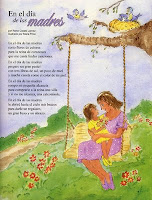
Mara Price is a bilingual author and illustrator. Originally from Mexico, Mara is an artist who writes and illustrates picture books and stories for children. Her articles, stories and illustrations are published in Iguana magazine for children. Mara lives in San Diego, California with her husband, Bill, daughter, Alena, and dog, Rosie.
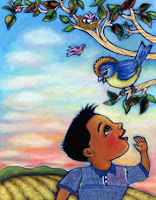 Leticia Teresa Pontoni lives in Córdoba, Argentina. She has been writing all her life. As a child, she wrote her first poems, stories and fairy tales. “There are some many good ideas going around,” Leticia says. She is always attentive for the right word, gesture or detail in order to convert them into beautiful poems and stories. How can you write a great story for children? This is Leticia’s vision: Think like a child, feel like a child, listen like a child, and create like a child. Dreams come true.
Leticia Teresa Pontoni lives in Córdoba, Argentina. She has been writing all her life. As a child, she wrote her first poems, stories and fairy tales. “There are some many good ideas going around,” Leticia says. She is always attentive for the right word, gesture or detail in order to convert them into beautiful poems and stories. How can you write a great story for children? This is Leticia’s vision: Think like a child, feel like a child, listen like a child, and create like a child. Dreams come true.
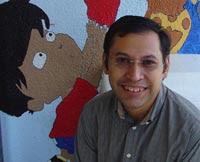 René Colato Laínez is the award winning author of I Am René, the Boy/ Soy René, el niño, Waiting for Papá/ Esperando a Papá, and Playing Lotería/ El juego de la lotería. His picture books have been honored by the Latino Book Award, the Paterson Prize for Books for Young People, and the California Collection for Elementary Readers. He is also a weekly children’s literature columnist for La Bloga . René was named “Top Ten New Latino Authors to Watch (and Read)” by latinostories.com. He is a graduate of the Vermont College MFA program in Writing for Children & Young Adults.
René Colato Laínez is the award winning author of I Am René, the Boy/ Soy René, el niño, Waiting for Papá/ Esperando a Papá, and Playing Lotería/ El juego de la lotería. His picture books have been honored by the Latino Book Award, the Paterson Prize for Books for Young People, and the California Collection for Elementary Readers. He is also a weekly children’s literature columnist for La Bloga . René was named “Top Ten New Latino Authors to Watch (and Read)” by latinostories.com. He is a graduate of the Vermont College MFA program in Writing for Children & Young Adults.
CAROL HEYER'S SILVER ANNIVERSARY

Come and Celebrate with Carol Heyer her twenty-fifth, "silver anniversary", picture book, HUMPHREY'S FIRST CHRISTMAS. It will be on November 10, 2007 at the Moorpark College Zoo. There will be an animal show that starts at 10:30, so if you can get there a little earlier that would be great. Bring a friend or your favorite child!
One of Humphrey's cousins will make an appearance at the show and books will be for sale from Adventures For Kids. After the show there will be refreshments, a Humphrey cake, Humphrey's Blanket Cookies, and of course chocolate!
America's Teaching Zoo
Moorpark College
7075 Campus Road
Moorpark, California 93021
http://www.vcnet.com/gwhiz/EATMprogram.htmlVisit Carol Heyer at
www.carolheyer.com.
René Colato Laínez
Thank you for your comments about my posts. Now I have a new day, los miércoles. Keep reading and look for my posts every Wednesday.
And following Manuel Ramo's post, these are the new bilingual children's books from Piñata Books, an imprint of Arte Público Press.
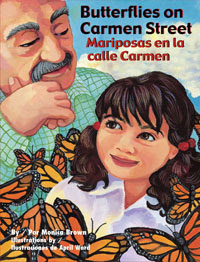
Butterflies on Carmen Street / Mariposas en la calle Carmen
by Monica Brown, April Ward (Illustrator), Gabriela Baeza Ventura (Spanish Translator)
This engaging bilingual picture book about migration combines the wonder of nature with the places we carry in our hearts
“Today is Butterfly Day!” Julianita excitedly tells her grandfather as they make their way down Carmen Street to school one morning. Today is the day Julianita and her friends have been waiting for—they’re going to learn about monarch butterflies. But what’s even more thrilling is they’re each going to receive their very own caterpillar to raise! When Julianita gets hers, she names him Tiger because of his striking yellow and black stripes.
Ms. Rodríguez teaches her students all about the monarch. But Julianita already knows that they fly south thousands of miles every winter because her grandfather remembers seeing the beautiful monarchs in his village in the highlands of Mexico. As the children feed and care for their caterpillars, they anxiously anticipate the transformation from caterpillar to chrysalis to butterfly.
When Tiger finally emerges from his chrysalis, Julianita doesn’t want to let him go. She worries that he will get lost on his way to Mexico. “Tiger knows the way to Mexico because it’s in his heart,” her Abuelito reassures her. She feels sad to see Tiger fly away, but Julianita knows that someday, she will follow him to her grandfather’s magical Mexico.
Paired with April Ward’s charming illustrations that depict Julianita’s neighborhood—her home on Carmen Street, the bench where Abuelito rests in Palo Verde Park, her parents’ store that sells everything in the whole wide world—this book by award-winning author Monica Brown is sure to entertain and educate kids ages 3-9. This is a perfect choice for children learning about insects and the forces of nature.

Ricardo’s Race / La carrera de Ricardo
by Diane Gonzales Bertrand, Anthony Accardo (Illustrator), Rocío Viegas-Barros (Spanish Translator)
This inspiring bilingual biography for children recounts the story of an All-American athlete and scholar
Ricardo Romo never dreamed that running to catch the school bus would lead to a college education, and ultimately, to a long and respected career as a teacher, administrator, and university president.
He grew up in San Antonio, Texas, the son of Mexican immigrants, and worked in his family’s small grocery store, where he learned to work hard and respect his family and neighbors. In school he learned that, as a Latino, he was expected to go to the technical high school rather than the one that prepared students for college, yet his teachers and coaches encouraged him to pursue his studies. They also fostered his natural athletic abilities as a runner.
In high school, Ricardo set numerous records in track and cross country, including the country’s second fastest recorded mile at that time. While still a sophomore, he began to receive invitations from colleges and universities urging him to consider running for their schools. Ultimately, he went on to run for the University of Texas at Austin, where he graduated with an undergraduate degree in history.
While injuries ended Ricardo’s hopes of competing in the 1968 Olympics, his educational dreams were achieved when he obtained a master’s degree from California State University, Northridge and a Ph.D. from the University of California at Los Angeles, both in history. Currently, he is the president of the University of Texas at San Antonio, and a time line detailing Dr. Romo’s accomplishments as an athlete and a scholar is included.
Award-winning author Diane Gonzales Bertrand presents an inspirational biography of this All American’s quest to accomplish his goals. With vivid, realistic illustrations by Anthony Accardo, emerging readers will be inspired to discover their own talents and chase their dreams.
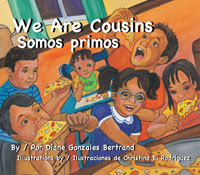
We Are Cousins / Somos primos
by Diane Gonzales Bertrand, Christina Rodriguez (Illustrator)
A simple bilingual text paired with colorful illustrations tells a loving, humorous story about playmates who are more than just friends
Cousins are friends and rivals. Cousins are funny and frustrating. But the most important thing is that cousins are family. We are Cousins / Somos primos celebrates the joy of this special family bond.
The children explain that they are cousins because their mothers are sisters, and from the moment they get together, the fun begins. They march in a make-believe parade, gobble up a pizza, and share a cozy story on Abuelo’s lap. But they also blame each other if something goes wrong, don’t want to share their toys, and wiggle against each other to nab a spot on Abuela’s lap.
Written in simple language for children ages 3-5, the brief English and Spanish text will become a valuable tool to encourage children to think and talk about their own families. It will also become a favorite book for children and grandchildren to share with their parents, grandparents, aunts, uncles, and of course, cousins.
Vivid illustrations by Christina Rodriguez in bright, primary colors complement this story that will be as much fun to read at story hour as it will be to read on the family sofa.
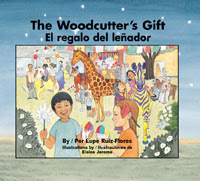
The Woodcutter’s Gift / El regalo del leñador
by Lupe Ruiz-Flores, Elaine Jerome (Illustrator)
This appealing bilingual picture book for children celebrates community and folk art
One day, a terrible thunderstorm knocked down the giant mesquite tree that grew in the town square. After the storm, the townspeople gathered to gawk at the large obstruction blocking the street. They weren’t sure what to do with it, but they all agreed that the wood was good for nothing except a fire.
But the woodcutter Tomás sees something in the huge tree that the rest of the townsfolk don’t. “The beauty of this tree is not on the outside but on the inside,” Tomás tells them. In the following days, everyone watches curiously as the woodcutter carves and chips and whittles the wood into blocks. At one point, he moves the chunks into his shed, increasing everyone’s curiosity. What could the woodcutter be doing with all that lumber?
Finally, Tomás calls the townsfolk together to see his creations: a wonderful collection of life-sized animals for the children to enjoy. Children and adults alike are thrilled with their private zoo! But a few weeks later the woodcutter is visited by strangers from a folk art museum who want to buy the pieces for their collection. Will Tomás sell the town’s new zoo animals so that others can enjoy them too?
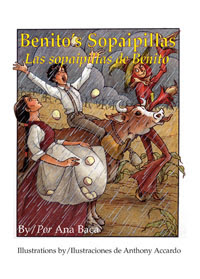
Benito’s Sopaipillas / Las sopaipillas de Benito
by Ana Baca, Anthony Accardo (Illustrator), Carolina Villarroel (Spanish Translator)
This tantalizing bilingual picture book for children shares the magical history of a favorite treat
Everyone loves the taste of the puffed pillows of fried bread known as sopaipillas, whether they’re drizzled with honey or sprinkled with cinnamon and sugar. But most people, young Cristina included, don’t know about this Southwestern treat’s magical origins, or how it got its name.
One hot summer morning, Cristina’s abuelita promises to teach her how to make the tasty fried bread and explain how she knows that making sopaipillas will bring rain! Long ago, Cristina’s great-grandfather Benito was desperate. His crops were dying because it hadn’t rained for months. One day, exhausted and weak from working the fields, Benito watched in amazement as a scarecrow came to life and begged him to help bring rain. The worried scarecrow claimed to know how. But could a scarecrow—and pieces of dough—really bring rain to the dry and dusty fields? Could Benito really save everyone’s crops?
And so Benito—and many years later his great-granddaughter Cristina—learned about the pillows of bread known as “soup catchers” that, like clouds, catch rain drops and bring them down to earth.
Benito’s Sopaipillas / Las sopaipillas de Benito is a magical bilingual picture book for children aged 3-7 that celebrates a delicious staple of Southwestern cuisine. And for those children who want to test the magic of the sopaipillas, a recipe is included in English and Spanish.
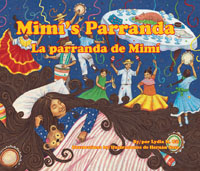
Mimí’s Parranda / La parranda de Mimí
by Lydia M. Gil, Hernán Sosa (Illustrator)
A Puerto Rican holiday tradition comes to life on the pages of this colorful bilingual picture book
Like most young children, Mimí loves Christmas time, so much so that she doesn’t even mind the bitter cold. But while her friends plan to ask for skates, sleds, coats and boots for Christmas, Mimí wants a straw hat, new sandals, a polka-dot bathing suit, and maybe even a beach ball. She’ll need toys and clothing for warm weather because she goes to Puerto Rico every Christmas, and she can’t wait to go again this year!
Mimí especially looks forward to her annual parranda, the Puerto Rican version of Christmas caroling. She loves it when everyone arrives late at night and wakes her up by playing their instruments—güiros, palitos, maracas, guitars, tambourines. And the food … she dreams about a table brimming with all her favorites: roasted pork, pasteles, and arroz con leche.
But when she learns that her family won’t be able to go to Puerto Rico this year, Mimí is crushed. She is so sad that she loses interest in her class’s holiday party, and on the day of the party, she decides to stay home in bed. Just as Mimí is falling asleep, though, she hears the unmistakable sounds of musical instruments. Could it be that she’ll get her parranda after all?
Rich with Puerto Rican cultural traditions and complemented by vibrant illustrations, Mimí’s Parranda / La parranda de Mimí will have children ages 3-7 eagerly anticipating their own holiday traditions.

Goodnight, Papito Dios / Buenas noches, Papito Dios
by Victor Villaseñor, José Ramírez (Illustrator)
Popular Chicano author shares his family’s bedtime story with children in English and Spanish
“Papá, I don’t want to go to sleep. I’m scared.”
Everyone knows that the trick to putting children to bed is creating a bedtime routine, and in this new children’s story from Victor Villaseñor, he recreates his own family’s bedtime tradition.
Papá tells his son that every night when he was a boy, his mother would sing him to sleep with the turtledove song. “Coo-coo-roo-coo-coooo,” he sings, and tells the little boy about his very own Guardian Angel who will take him through the night sky to be reunited with God, or Papito Dios. “Then in the morning, you’ll come back refreshed, rested, and powerful as the wind.”
As Papá sings the turtledove song to his son, he reminds the child that Mamá loves him, the dog and the cat love him, and his brothers and sisters love him too. Even the trees and grass and the flowers that dance in the wind love him. Gradually, the boy drifts off to sleep, feeling safe and warm in God’s love and dreaming of the day when he will sing the turtledove song to his own children.
 The synthesis referred to in the title is the ability of a person to combine the primary process and secondary process of the brain. The primary process is concerned with the subconscious workings of the brain: dreams, imagery, associations. The secondary process is concerned with logical thinking or how we express our primary thinking to the outside. The "magic synthesis" is the result of an individual merging these two processes, and then creating metaphors, symbols, abstractions and a new way of seeing or thinking about the world.
The synthesis referred to in the title is the ability of a person to combine the primary process and secondary process of the brain. The primary process is concerned with the subconscious workings of the brain: dreams, imagery, associations. The secondary process is concerned with logical thinking or how we express our primary thinking to the outside. The "magic synthesis" is the result of an individual merging these two processes, and then creating metaphors, symbols, abstractions and a new way of seeing or thinking about the world.




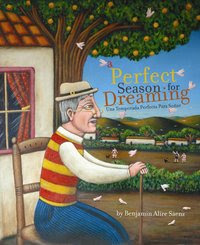
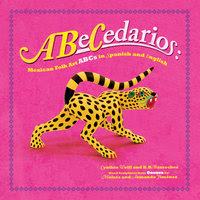
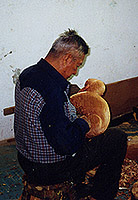






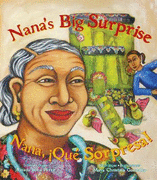

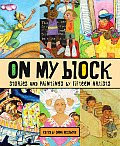



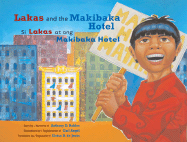
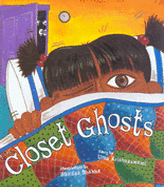

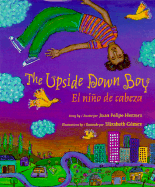

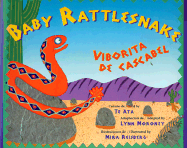
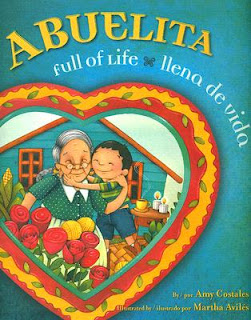








Loved the premise of Huevos y la Mujer Latina.
There's meat for some heavy discussions! We'd have to first read the book, though.
RudyG